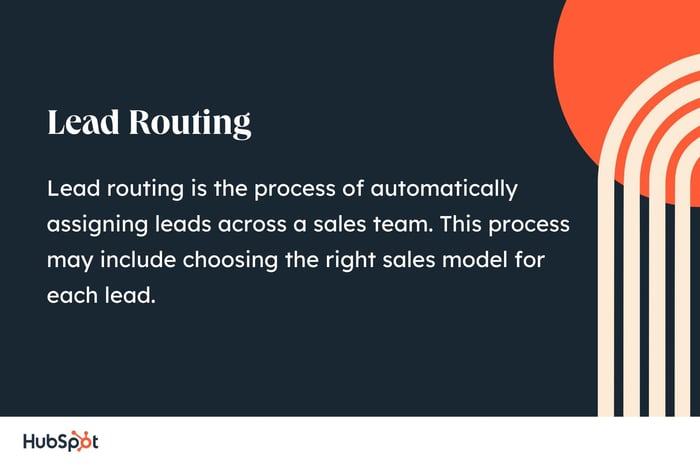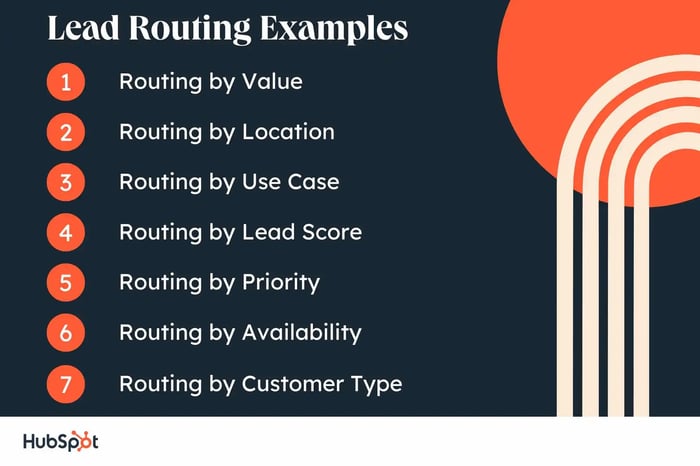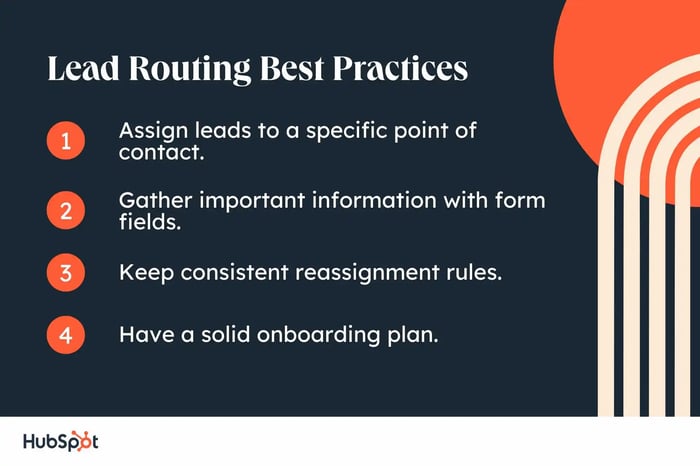Correctly routing leads and responding quickly can make or break a deal. The more mature a business gets and the more complex the prospect’s needs, the more challenging maintaining a speedy response and personalized touch become.

Growing businesses require more sophisticated automation to ensure operational efficiency and proper lead distribution.
That’s what makes lead routing a critical component of any scaling sales strategy.
So, what is lead routing?
At its most fundamental, lead routing is the process of automatically assigning leads across a sales team. If your company has more than one sales approach — like self-serve, transactional, and enterprise — lead routing involves passing potential customers to the proper sales model.
Automated lead routing can be simple, such as a round-robin assignment to your sales reps based on who is next in line. Mature lead routing models take multiple factors into account. That includes deal value, territory or geography, use case or specialization, or a combination of multiple factors by a lead scoring system.
Unless you’re in a niche industry, chances are your business attracts more than one type of customer. Lead routing ensures the right prospects reach the right representative at the right time to save your business time and resources.

Seven Lead Routing Examples
1. Lead Routing by Value
Companies like Slack and Dropbox popularized the hybrid approach of building a self-serve business in tandem with an enterprise one. This approach maximizes operational efficiency by keeping the most expensive resource — the sales rep’s time — focused on building relationships and closing larger deals. Smaller deals are routed to a low-touch, high-volume, one-to-many sales model.
Tools like Clearbit can help pull in data about a customer's company size and value to pre-populate CRM data. Using this data, low-value leads can be handled by self-serve marketing automation. Here, human touch is provided by customer support teams answering incoming questions.

High-value leads can be sent directly to sales teams to guide high-value, complex deals through an enterprise sales process.
Pro tip: Consider how long a lead will take to turn into a customer. Before assigning a lead, make sure that the sales rep has the time to take on that amount of work.
2. Lead Routing by Location
For industries tied to brick-and-mortar stores or geographical locations, defining territories is a common practice. Leads are assigned by location, enabling sales teams to divide and conquer regionally.
Routing leads by geography provides certainty that reps aren’t stepping on each other’s toes with double coverage, while completely neglecting others.
If a lead is routed to a salesman in the same time zone, it’s going to be much easier for everyone involved. Meetings can be scheduled without the hassle of finding a time that works for everyone.
Determining lead routing based on location also means that if an in-person sales pitch or meeting is necessary, those included won’t have to travel as far. This foresight saves your organization time and money.
To begin lead routing, you must first define your territories and organize your CRM data around those definitions. With the right CRM and automated toolset, you can sort records into territories. From there, assign leads to any reps working within that territory using round-robin automation.
Pro tip: If a lead has a high value, work harder to gather as much information about that lead as possible using social media (such as LinkedIn). Then, match them with a rep who has similar interests in their territory. This will make your calls more personable and compelling, and a deal more likely.
3. Lead Routing by Use Case or Specialization
Many tools and systems, especially in SaaS, have multiple relevant use cases. Let’s take a tool like HubSpot as an example. HubSpot serves customer service teams, sales teams, and marketing teams. Each group comes with its own buyer personas, choosers, users, and influencers.
Trello offers another example. This virtual whiteboard might be used for anything from wedding planning to software bug triage.
Savvy sales teams know that industry expertise helps establish the trusted advisor relationship requisite to closing the big deals, which makes lead routing by specialization or use case increasingly important for enterprise sales models.
Let’s take an example of software targeted to creative firms, encompassing graphic design, animation, film editing, and illustration. It’s unlikely all sales reps will develop the expertise needed to speak to the needs of all of those varied professionals, even if they do sit under a similar umbrella.
Instead, you may have your top sales reps cover the largest deals that involve multiple products across a company, but route smaller, more specialized deals to reps who specialize in particular areas.
Pro tip: When a specialized or niche lead comes through, be sure to mention other customers you have in the same industry. Consider emailing over glowing reviews from these customers. This will help your leads understand the experience you have with their industry’s concerns and problems.
4. Lead Routing by Lead Score
The most sophisticated sales models implement lead scoring as part of their lead routing process. Lead scoring assigns a quantifiable value to every lead generated for the business, usually by a numerical point system.
Leads can be scored on multiple attributes, including:
- Value.
- Geography.
- Use case.
- Engagement with your company.
- Company size.
Lead scoring helps sales teams prioritize leads, and apply a more tailored approach to engagement. With this method, you can close more leads with less effort. Lead scoring can also help define whether a lead needs more time being nurtured, could close with a low-touch one-to-many approach, or requires high-touch consultative efforts.
Pro tip: Route only those with scores ready for sales to your sales team to maximize time and effort. This results in a happy and productive sales team by minimizing the frustration of poor leads.
5. Lead Routing by Priority
There are many factors to consider when determining the priority of a lead. The potential sales value is important, but you should also consider the lead’s position within their organization, their buying power, their engagement level with your products and content, and the product type(s) they are interested in.
Pro Tip: Consider adding a form field that asks how urgently they need a product or solution to determine if a lead is casually browsing or seriously looking.
6. Lead Routing by Availability
While this shouldn’t be a first-case scenario, routing leads based on representatives’ availability is still an important factor to consider. If a sales rep has a lot on their plate or is working on a larger deal, they will not have the energy or focus to give new leads their best effort. Initially contacting leads and answering lead questions quickly are both essential to the success of a deal.
Pro Tip: Make sure sales representatives constantly keep their calendars updated with meetings, time off, and other engagements, allowing you to easily automate leads based on availability.
7. Lead Routing by Customer Type
By the time a lead enters your pipeline, you should know if their organization is a current customer or not. This information can be leveraged to assign leads to the best possible point of contact.
For example, if a lead’s organization is already a customer, they should be passed on to a customer success manager who can walk them through the sales agreement their company has.
If their organization is not a customer, then an assigned salesperson can qualify the lead before moving them onto an account executive. This segmentation will streamline and simplify your lead routing process.
Pro tip: Develop a path for former customers looking to return to your organization. Ensure that your representative knows your prior history with the buyer.

Lead Routing Best Practices
Regardless of the lead route(s), you choose for your company, here are some best practices you should keep in mind.
Assign leads to a specific point of contact.
Nurturing leads is essential to increasing both new sales and retention. As leads enter the demand generation pipeline, they should know their point of contact for each step of the journey. If a lead isn’t a current customer, then they should have an assigned salesperson who will reach out and discuss products with them.
If a lead is a current customer, then they should be assigned to a customer success manager. A CSM should be familiar enough with the lead’s organizational needs to reach out with education on new products or current promotions.
Pro tip: Depending on what software you use for managing leads, assigning leads to a salesperson can be automated. As soon as a potential lead expresses interest, they receive an email with the next steps and the name of their point of contact.
Gather important information with form fields.
Your forms are essential to successful conversions. A poorly planned or too personal a form will make you look difficult to work with, turning leads away.
A typical form asks your lead their name, their organization, organization size, location, a phone number to contact them. You may also ask what product(s) they are interested in.
Pro tip: When it comes to form fields, less is more. You can follow up with more specific details down the road.
Keep consistent reassignment rules.
You can improve your customer experience by rerouting leads when a sales rep can’t get to them fast enough. Sales teams will often have a round-robin lead assignment process.
Consider what amount of time makes the most sense for reassignment, and then add that criteria to your lead routing software. Quickly responding to leads can make the conversion process quicker and more seamless for everyone involved.
Pro Tip: Consider publishing personable blurbs about each of your sales reps online and giving leads access to their calendars. This allows customers to choose who they want to speak with.
Have a solid onboarding plan.
As soon as a lead moves past the purchase stage, quick and valuable onboarding is essential.
Make sure an assigned CSM reaches out to new customers with a welcome email that includes specific next steps on how to integrate your product. Consider scheduling a quick phone or video call to review how to navigate any software.
Remember, the bottom of the demand generation pipeline is retention. Quickly offering value during onboarding is a key factor in reducing churn.
Pro tip: Make sure your onboarding process is a personalized experience by celebrating customer milestones. Check out this guide to create a customer onboarding strategy and plan.

Getting Started
Getting started with lead routing is simple if you have the right tools, including a CRM with automation capabilities and a tool for lead scoring, such as HubSpot partner MadKudu.
To develop lead routing paths, you will need to:
- Define your lead routing criteria, like value, use case, territory, or lead score.
- Create workflows or automations based on that criteria.
- Qualify leads and divide them between your reps.
To improve and optimize your lead routing, you need to know what’s working and what’s not. Monitor and report on the successes or shortcomings of routing to understand what’s working.
Want more insight? Learn how to manage and nurture sales leads from HubSpot Academy.






![How to Develop a Strategic Plan for Business Development [Free Template]](https://blog.hubspot.com/hubfs/Copy%20of%20Featured%20Image%20Template%20Backgrounds-2.png)




